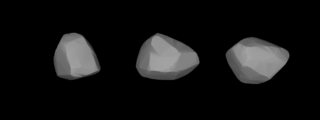
Klytia is a main-belt asteroid. It was the second and last asteroid discovery by the prolific comet discoverer Horace Tuttle, on April 7, 1862. It is named after Clytia, who loved Helios in Greek mythology. Of the first one hundred numbered asteroids, Klytia is the smallest.

137 Meliboea is a large, dark main-belt asteroid that was discovered by Austrian astronomer J. Palisa at the Austrian Naval Observatory on 21 April 1874, the second of his many asteroid discoveries. It was later named after Meliboea, the daughter of Oceanus and Tethys in Greek mythology. The largest body in the Meliboea family of asteroids that share similar orbital elements, only 791 Ani approaches its size. It is classified as a C-type asteroid and may be composed of carbonaceous materials. The spectra of the asteroid displays evidence of aqueous alteration.

Una is a fairly large and dark, primitive Main belt asteroid that was discovered by German-American astronomer C. H. F. Peters on February 20, 1876, in Clinton, New York. It is named after a character in Edmund Spenser's epic poem The Faerie Queene (1590).

168 Sibylla is a large main-belt asteroid, discovered by Canadian-American astronomer J. C. Watson on September 28, 1876. It was most likely named for the Sibyls, referring to the Ancient Greek female oracles. Based upon its spectrum this object is classified as a C-type asteroid, which indicates it is very dark and composed of primitive carbonaceous materials. 168 Sibylla is a Cybele asteroid, orbiting beyond most of the main-belt asteroids.

Philosophia is a large main-belt asteroid that was discovered by the French astronomer Paul-Pierre Henry on August 12, 1882, in Paris and named after the topic of philosophy. Based upon photometric observations, it has a synodic rotation period of 52.98 ± 0.01 with a brightness variation of 0.15 ± 0.02 in magnitude.

Ilse is a Main belt asteroid. It has an unusually slow rotation period, about 3.5 days.

Atropos is a typical Main belt asteroid that was discovered by Austrian astronomer Johann Palisa on 8 March 1888 in Vienna.

Clorinde is a typical Main belt asteroid. It was discovered by Auguste Charlois on 28 January 1889 in Nice. It was named after Clorinda, the heroine of Torquato Tasso's poem Jerusalem Delivered.

Thora is a 17 km Main belt asteroid with a potentially long 274-hour rotation period. It was discovered by Johann Palisa on 6 October 1890 in Vienna.

360 Carlova is a very large main-belt asteroid. It is classified as a C-type asteroid and is probably composed of carbonaceous material. The asteroid has a convex, roughly ellipsoid shape. The sidereal rotation period is 6.1873 hours with an axis of rotation along the ecliptic coordinates (l, b) = (95°±3°, 40°±1°). It was discovered by Auguste Charlois on 11 March 1893 in Nice.

Senta is a minor planet orbiting the Sun that was discovered by German astronomer Max Wolf on 16 November 1904, from Heidelberg.

Kundry is an S-type asteroid belonging to the Flora family in the Main Belt. Its rotation period is 12.605 hours.
774 Armor is a minor planet orbiting in the main belt. It was discovered on 13 December 1913, in Paris by French astronomer Charles le Morvan and was named after the Celtic region of Armorica. The asteroid is orbiting at a distance of 3.05 AU with a period of 5.32 yr and an eccentricity of 0.169. The orbital plane is inclined by an angle of 5.56° to the plane of the ecliptic.
883 Matterania is an S-type asteroid belonging to the Flora family in the Main Belt. Its rotation period is 5.64 hours
901 Brunsia is an S-type asteroid belonging to the Flora family in the Main Belt. Its rotation period is 3.136 hours.

915 Cosette is an S-type asteroid belonging to the Flora family of Main Belt asteroids. Its rotation period is 4.445 hours.
937 Bethgea is a background asteroid from the inner region of the asteroid belt. It was discovered on 12 September 1920 by German astronomer Karl Wilhelm Reinmuth, from Heidelberg.
990 Yerkes is a main belt asteroid discovered by Belgian-American astronomer George Van Biesbroeck in 1922, and named after the Yerkes Observatory.
51823 Rickhusband, provisional designation 2001 OY28, is a dark Lixiaohua asteroid from the outer regions of the asteroid belt, approximately 9 kilometers in diameter.
6144 Kondojiro (1994 EQ3) is an asteroid discovered on March 14, 1994 by Kin Endate and Kazuro Watanabe at the Kitami Observatory in eastern Hokkaidō, Japan. It is named after Jiro Kondo, a Japanese Egyptologist and professor of archaeology at Waseda University.













